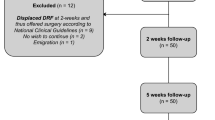Abstract
Distal radius fractures are the most common upper extremity fracture, representing one-sixth of all fractures treated in emergency departments nationwide. Beyond the initial reduction and immobilization of these fractures, providing proper followup to ensure maintenance of the reduction and identify complications is necessary for optimal recovery of forearm and wrist functions. We sought to identify the clinical and demographic factors that characterize patients with distal radius fractures who do not return for followup and to assess the underlying causes for their poor followup rates. Compared with patients who were compliant with followup, those lost to followup had lower Physical and Mental Health scores on the SF-36 forms, more often were treated nonoperatively, and more likely had not surpassed secondary education. However, we found no difference between these two groups based on age, gender, mechanism of injury, marital status, or hand dominance. Early identification of patients who potentially are noncompliant can result in additional measures being taken to ensure the patient’s return to the treating hospital and physicians. This in turn will prevent complications attributable to lack of followup and allow more accurate assessment of results, thereby improving patient outcomes.
Similar content being viewed by others
References
Beaton DE, Katz JN, Fossel AH, Wright JG, Tarasuk V, Bombardier C. Measuring the whole or parts? Validity, reliability, and responsiveness of the Disabilities of the Arm, Shoulder, and Hand outcome measure in different regions of the upper extremity. J Hand Ther. 2001;14:128–146.
Gofton W, Liew A. Distal radius fractures: nonoperative and percutaneous pinning treatment options. Orthop Clin North Am. 2007;38:175–185, v–vi.
Ilyas AM, Jupiter JB. Distal radius fractures: classification of treatment and indications for surgery. Orthop Clin North Am. 2007;38:167–173, v.
MacDermid JC, Roth JH, Richards RS. Pain and disability reported in the year following a distal radius fracture: a cohort study. BMC Musculoskelet Disord. 2003;4:24.
Mackenney PJ, McQueen MM, Elton R. Prediction of instability in distal radius fractures. J Bone Joint Surg Am. 2006;88:1944–1951.
McKay SD, MacDermid JC, Roth JH, Richards RS. Assessment of complications of distal radius fractures and development of a complication checklist. J Hand Surg Am. 2001;26:916–922.
Murnaghan ML, Buckley RE. Lost but not forgotten: patients lost to follow-up in a trauma database. Can J Surg. 2002;45:191–195.
Murray DW, Britton AR, Bulstrode CJ. Loss to follow-up matters. J Bone Joint Surg Br. 1997;79:254–257.
Norquist BM, Goldberg BA, Matsen FA 3rd. Challenges in evaluating patients lost to follow-up in clinical studies of rotator cuff tears. J Bone Joint Surg Am. 2000;82:838–842.
Orthopaedic Trauma Association Committee for Coding and Classification. Fracture and dislocation compendium. J Orthop Trauma. 1996;10(suppl 1):v–ix,1–154.
Psaty BM, Cheadle A, Koepsell TD, Diehr P, Wickizer T, Curry S, VonKorff M, Perrin EB, Pearson DC, Wagner EH. Race- and ethnicity-specific characteristics of participants lost to follow-up in a telephone cohort. Am J Epidemiol. 1994;140:161–171.
Smith JS, Watts HG. Methods for locating missing patients for the purpose of long-term clinical studies. J Bone Joint Surg Am. 1998;80:431–438.
Solway S, Beaton DE, McConnell S, Bombardier C. The DASH Outcome Measure User’s Manual. Toronto, Canada: Institute for Work and Health; 2002.
Turner RG, Faber KJ, Athwal GS. Complications of distal radius fractures. Orthop Clin North Am. 2007;38:217–228, vi.
US Census Bureau. Migration of the young, single, and college educated: 1995–2000. Available at: http://www.census.gov/prod/2003pubs/censr-12.pdf. Accessed January 28, 2009.
Ware JE, Kosinski M, Keller SD. SF-36 Physical and Mental Health Summary Scales: A User’s Manual. Boston, MA: The Health Institute, New England Medical Center; 1994.
Ware JE, Snow KS, Kosinski M, Gandek B. SF-36 Health Survey and Interpretation Guide. Boston, MA: The Health Institute, New England Medical Center; 1994.
Zunzunegui MV, Beland F, Gutierrez-Cuadra P. Loss to follow-up in a longitudinal study on aging in Spain. J Clin Epidemiol. 2001;54:501–510.
Author information
Authors and Affiliations
Corresponding author
Additional information
Each author certifies that he or she has no commercial associations (eg, consultancies, stock ownership, equity interest, patent/licensing arrangements, etc) that might pose a conflict of interest in connection with the submitted article.
Each author certifies that his or her institution has approved the human protocol for this investigation, that all investigations were conducted in conformity with ethical principles of research, and that informed consent for participation in the study was obtained.
About this article
Cite this article
Tejwani, N.C., Takemoto, R.C., Nayak, G. et al. Who Is Lost to Followup?: A Study of Patients with Distal Radius Fractures. Clin Orthop Relat Res 468, 599–604 (2010). https://doi.org/10.1007/s11999-009-0968-6
Received:
Accepted:
Published:
Issue Date:
DOI: https://doi.org/10.1007/s11999-009-0968-6




